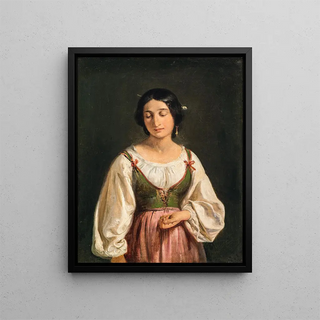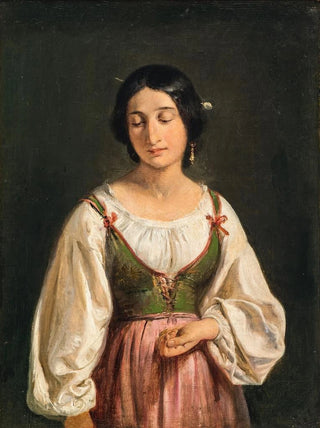Art print | Study of an Italian woman standing for a milk seller - Wilhelm Marstrand


View from behind

Frame (optional)
The artwork titled "Study of an Italian Woman Standing for a Milk Seller" by Wilhelm Marstrand is a captivating piece that transports the viewer to the heart of 19th-century Italian daily life. Capturing a fleeting moment, the artist manages to evoke deep emotions and an atmosphere imbued with simplicity and beauty. The depicted woman, with her graceful demeanor and contemplative gaze, embodies the very essence of Italian culture, where tradition and nature intertwine harmoniously. This work, both intimate and universal, invites reflection on the human condition and the relationship with nature, while celebrating the beauty of everyday life.
Style and uniqueness of the work
Marstrand's style is distinguished by remarkable finesse and meticulous attention to detail. In this study, warm, earthy colors evoke the soft light of Italy, while the composition, both balanced and dynamic, guides the viewer's eye. The woman, dressed in traditional attire, is depicted in a posture that suggests both strength and delicacy. The features of her face, tinged with a certain melancholy, reveal a psychological depth that makes the piece particularly touching. Marstrand excels in capturing the nuances of human expression, and this piece is no exception. The light, playing on the textures of the clothing and the softness of the skin, adds an almost tactile dimension to the canvas, creating a dialogue between the artwork and the observer.
The artist and his influence
Wilhelm Marstrand, an emblematic figure of the Danish Romantic movement, established himself through his unique style and his ability to grasp the essence of the subjects he depicts. Influenced by his travels in Italy, he incorporated elements of Italian culture into his work, thereby enriching his artistic vocabulary. Marstrand does not merely paint genre scenes; he manages to breathe soul into his characters, making them accessible and universal. His work has inspired many contemporary and later artists, who saw in him a model of sensitivity and technical mastery.

Matte finish

View from behind

Frame (optional)
The artwork titled "Study of an Italian Woman Standing for a Milk Seller" by Wilhelm Marstrand is a captivating piece that transports the viewer to the heart of 19th-century Italian daily life. Capturing a fleeting moment, the artist manages to evoke deep emotions and an atmosphere imbued with simplicity and beauty. The depicted woman, with her graceful demeanor and contemplative gaze, embodies the very essence of Italian culture, where tradition and nature intertwine harmoniously. This work, both intimate and universal, invites reflection on the human condition and the relationship with nature, while celebrating the beauty of everyday life.
Style and uniqueness of the work
Marstrand's style is distinguished by remarkable finesse and meticulous attention to detail. In this study, warm, earthy colors evoke the soft light of Italy, while the composition, both balanced and dynamic, guides the viewer's eye. The woman, dressed in traditional attire, is depicted in a posture that suggests both strength and delicacy. The features of her face, tinged with a certain melancholy, reveal a psychological depth that makes the piece particularly touching. Marstrand excels in capturing the nuances of human expression, and this piece is no exception. The light, playing on the textures of the clothing and the softness of the skin, adds an almost tactile dimension to the canvas, creating a dialogue between the artwork and the observer.
The artist and his influence
Wilhelm Marstrand, an emblematic figure of the Danish Romantic movement, established himself through his unique style and his ability to grasp the essence of the subjects he depicts. Influenced by his travels in Italy, he incorporated elements of Italian culture into his work, thereby enriching his artistic vocabulary. Marstrand does not merely paint genre scenes; he manages to breathe soul into his characters, making them accessible and universal. His work has inspired many contemporary and later artists, who saw in him a model of sensitivity and technical mastery.






